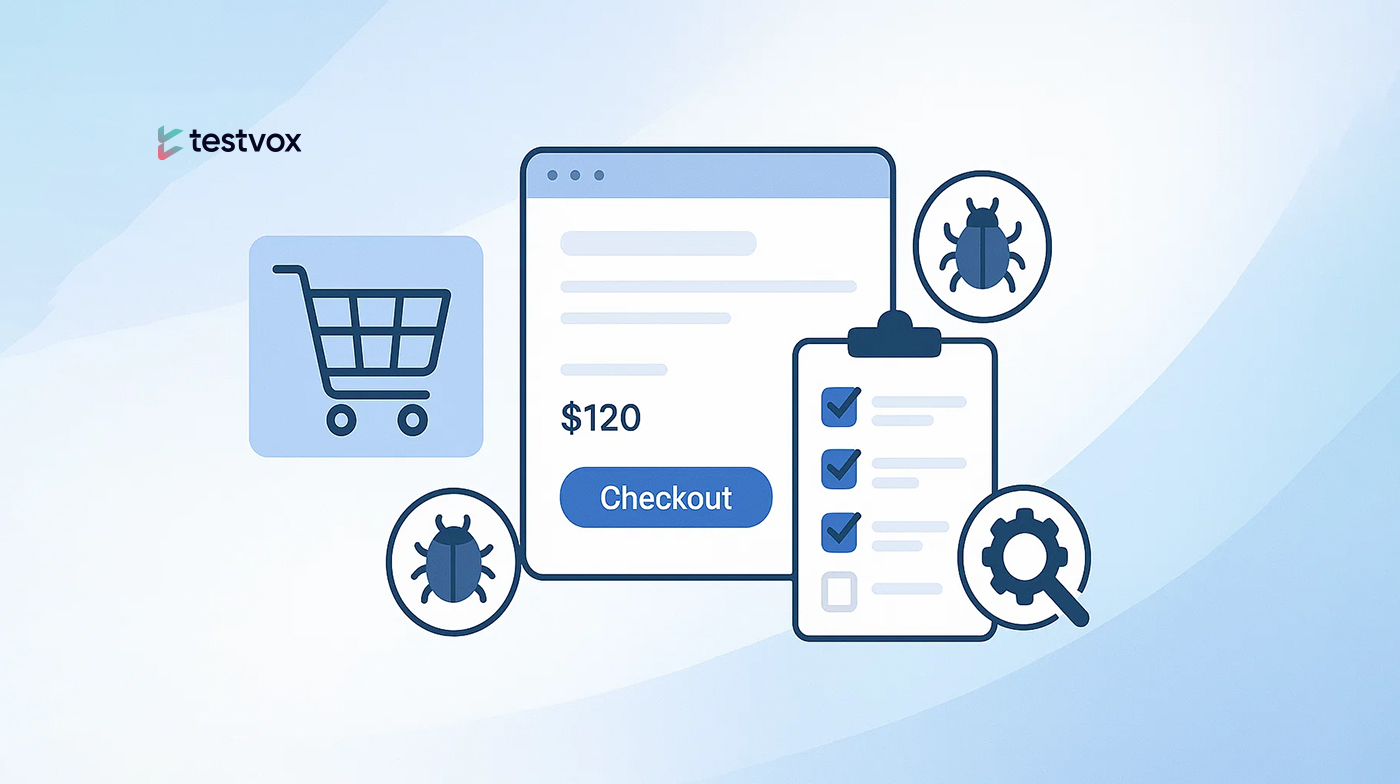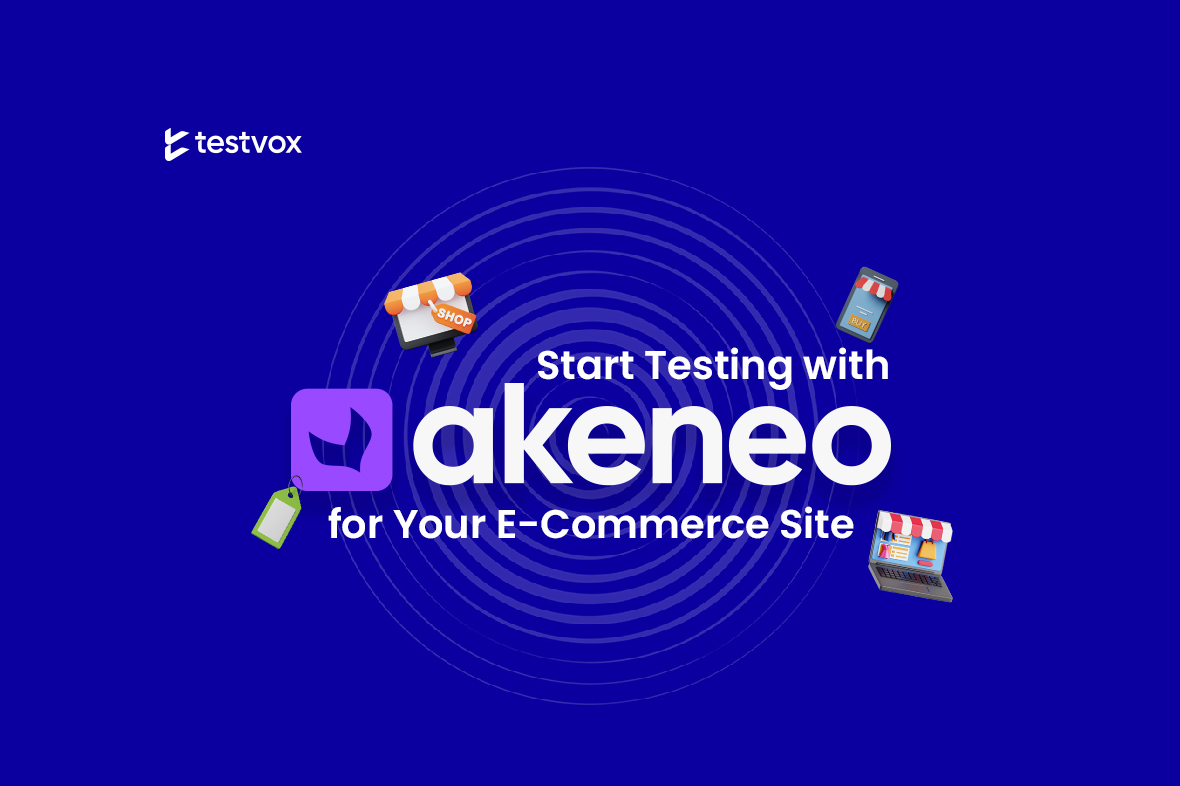 5 August 2025
5 August 2025

E-commerce Cart and Checkout Functionality Testing: Common Bugs, Test Cases, and Best Practices
 6 October 2025
6 October 2025
 11:11 MIN Read time
11:11 MIN Read time
The core of any e-commerce website is the checkout and cart process. A minor error in this area can cost companies repeat business, trust, and sales. For this reason, QA teams cannot compromise on adequately testing these flows.Since shopping carts and checkouts are the most common sites for issues to occur on any shopping website, it is crucial to check for them. When these elements function well, customers are more satisfied with their purchases and the company performs better. Teams can ensure that the cart and checkout process function well for all users by identifying common flaws, going over crucial test procedures and scenarios, and developing solid testing practices.
Most Common E-Commerce Shopping Cart Bugs
A key component of online purchasing, the shopping cart is also one of the most prone to mistakes, which can have a direct effect on sales and consumer happiness. The following are some of the most prevalent cart defects that QA teams should extensively test:
1. Incorrect Cart Calculations: Customers may become confused or mistrustful if the cart’s total price or subtotal is calculated incorrectly when they add items from multiple categories. This occurs when item prices are added up incorrectly, taxes are applied inconsistently, or discounts are applied improperly across categories.
2. Discount and Coupon Failures: Although discounts are a strong promotional tool, mistakes can significantly reduce conversions. Occasionally, users are unable to complete their orders because promo codes do not apply correctly or the system may provide unexpected errors when specific coupons are added.
3. Cart Resetting on Refresh or Login: Customers find their cart empty after adding items to it and then refreshing the page or logging back in—this is a frustrating bug. This lack of browser persistence affects the purchasing flow and may cost you potential consumers.
4. Out-of-Stock Products Still Added: If the out-of-stock label is not displayed on product listings or information pages, users can add unavailable goods to their cart. At the last minute, they become disappointed since they only receive errors like “Please remove the out-of-stock items” when they are in the cart phase.
5. Missing Breadcrumbs for Navigation: Breadcrumbs help users understand where they are in the shopping journey and make reverse navigation effortless. Customers find it harder to go back and change earlier steps when these navigational elements are frequently removed from carts.
6. Inconsistent Product Details Across Pages: Differences in product images, styles, colours, sizes, or prices between the product listing page (PLP), product detail page (PDP), and cart can confuse customers and reduce trust in the platform.
7. Shipping Charge Errors for Cash on Delivery (COD): Sometimes the cart includes COD charges when they should be free, or it displays free shipping when COD has an additional cost. Such variations may result in abandoned carts or confusion at checkout.
8. UI Elements Not Working on Some Browsers: The cart’s buttons, fields, dropdown menus, and checkboxes could not work properly in every browser, which would make it more difficult and annoying for users to change the items in their cart.
9. Failure to Remove Products: Clicking the “remove” (X) button should immediately delete the item from the cart. However, some carts do not remove products correctly, leaving users unsure whether their action succeeded.
10. “Remove All Items” Button Issues: The entire cart should be cleared at once when you click the “Remove all items” option. Customers get annoyed during cleanup because it occasionally refreshes the site without entirely emptying the cart.
Thoroughly analysing and testing these cart problems improves user experience, lowers abandonment rates, and helps avoid unpleasant breakdowns in the purchasing process.
Testing the performance of a highly scalable e-commerce application by Testvox
Most Frequent E-commerce Checkout Bugs
Customers confirm their orders and pay during the checkout process, which is the last and most important stage of online buying. sadly, it also has problems that can prevent conversions and undermine user confidence. The most frequent checkout problems that testers need to find and fix are listed below:
1. Guest User Order Failures: While many websites let customers shop without having an account, occasionally issues exist that prevent orders from being completed. These problems, which result in the process becoming stuck without enough feedback, are frequently caused by backend bugs, payment gateway difficulties, or incomplete validations.
2. Address Validation Mismatches: Checkout address fields may accept fake or dummy addresses but reject legitimate ones due to backend logic problems. This leads to user frustration and abandoned carts, as buyers are blocked without a clear explanation.
3. Payment Service Failures: While payment gateways like Cards, Tabby, Tamara, GPay, Apple Pay, or PayMob may show transactions as complete, the order fails to register in the checkout database. This discrepancy risks lost orders, billing errors, and poor customer experience.
4. Lack of HTTPS Security: A checkout page without HTTPS exposes sensitive customer data to security threats. Absence of secure connection symbols (like a lock icon) deters users from entering personal or payment information.
5. Product and Price Summary Mismatches: When ordering multiple products or shipping to different countries, the final summary sometimes mismatches product lists or prices compared to earlier steps, creating confusion or distrust.
6. Missing or Broken Order Confirmation Emails: After completing an order, customers expect immediate email confirmation. However, some orders result in missing emails, incomplete data, or confusing links with long redirections, undermining confidence in the purchase.
7. Autofill Issues in Address and Email Fields: Auto-fill features are designed to speed up checkout, but sometimes fail to populate the address or email fields, forcing users to type everything manually and risking abandonment.
8. Data Loss on Page Refresh or Navigation: If users accidentally refresh the page or navigate backwards, all previously entered form data may vanish, requiring them to re-enter details—a frustrating experience that risks cart abandonment.
9. Incorrect Tax Calculations Across Countries: Tax rules vary by region, but sometimes the checkout applies wrong tax rates or calculates taxes differently than those shown in the cart, resulting in price mismatches and customer complaints.
10. Phone Number Field Validation Errors: Validation problems that display ambiguous “something went wrong” notifications might deter clients from completing orders, even when phone numbers are formatted correctly.
Finding and resolving these checkout issues is essential to preserving an uninterrupted purchasing process and avoiding cart abandonment at the very last step.
E-commerce Cart Test Cases Every QA Team Should Run
To ensure the shopping cart works flawlessly, all key functions must be thoroughly tested. These test scenarios are important for identifying defects and guaranteeing an error-free experience for customers:
| Test Case ID | Test Scenario | Steps to Reproduce | Expected Result |
| TC-CART-001 | Cart Quantity Management | 1. Add a product to the cart.
2. Increase the item quantity. 3. Decrease the item quantity. 4. Remove the item from the cart. |
1. Item appears in cart with quantity 1.
2. Quantity increases by 1, price updates correctly. 3. Quantity decreases by 1, price updates correctly. If quantity is 1, decreasing removes the item. 4. Item is removed from the cart, and the cart total updates. |
| TC-CART-002 | Real-time Price Calculation | 1. Add multiple products with different prices to the cart.
2. Change the quantity of items. 3. Remove an item. 4. Apply a valid discount code (see TC-CART-003). |
After every action (add, change quantity, remove, apply promo), the subtotal, taxes, shipping (if applicable), and grand total are recalculated and displayed correctly immediately. |
| TC-CART-003 | Discount Code Application | 1. Navigate to the cart with items.
2. Apply a valid discount code. 3. Apply an invalid/expired discount code. 4. Remove the applied valid discount code. |
1. Code is accepted, discount is applied, and the total price updates. A success message appears.
2. Code is rejected, an error message appears (e.g., “Invalid code”), and the total price remains unchanged. 3. The discount is removed, and the total price reverts to the original amount. |
| TC-CART-004 | “Save for Later” Feature | 1. Add an item to the cart.
2. Click “Save for Later” for the item. 3. Move the item back from “Save for Later” to the active cart. |
1. Item is in the active cart.
2. Item is moved to a “Save for Later” section. The active cart total updates, excluding this item. 3. Item is moved back to the active cart, and the cart total is updated to include the item’s price. |
| TC-CART-005 | Cart Persistence After Logout/Login | 1. Log into a user account.
2. Add items to the cart. 3. Log out of the account. 4. Log back into the same account. |
The cart retains all the items that were added in step 2 after logging back in. |
| TC-CART-006 | Cart Persistence After Browser Session | 1. Add items to the cart.
2. Close the browser completely. 3. Reopen the browser and navigate back to the website. |
The items remain in the cart. (This tests the use of cookies or local storage for cart data). |
| TC-CART-007 | Handling Out-of-Stock Products | 1. Attempt to add a product that is displayed as “Out of Stock” to the cart.
2. Add a product to the cart, then simulate it going out of stock before checkout (e.g., by another user buying the last one). |
1. The “Add to Cart” button is disabled or a message prevents the action.
2. Upon viewing the cart or proceeding to checkout, a clear warning message appears (e.g., “Sorry, ‘Product X’ is no longer available in the requested quantity”). The item may be grayed out or removed. |
| TC-CART-008 | Mobile Responsiveness and Functionality | 1. Access the cart page on a mobile device (or using browser developer tools).
2. Perform key actions: change quantities, apply discount, proceed to checkout. |
The cart interface is usable and visually appealing on a small screen. All buttons, links, and input fields are correctly sized and functional (e.g., touch-friendly). Layout does not break. |
| TC-CART-009 | Handling Large Quantities | 1. Add a very high number (e.g., 9999) of a single item to the cart.
2. Add many different items to the cart, exceeding a typical number (e.g., 50 unique items). |
The system handles the input correctly. The price calculates accurately. The page performance is not significantly degraded. The layout remains usable without horizontal scrolling or element breakage. |
| TC-CART-010 | Product Name Link Navigation | 1. In the cart, click on the product name or image link for an item. | The user is correctly redirected to the product detail page for that specific item. |
| TC-CART-011 | Automated Promotion Application | 1. Add items to the cart that qualify for a promotion (e.g., “Buy 2, get 10% off” or “Free shipping on orders over $50”).
2. Adjust the cart to no longer meet the promotion criteria. |
1. The promotion is automatically applied without needing a code. A message confirms the promotion. The discount is reflected in the total.
2. The promotion is automatically removed, and the total price is updated accordingly. |
E-commerce Checkout Test Cases
Considering the checkout procedure is the last stage before a sale is finalized, it is key that you adequately test every scenario that could arise. To ensure that customers have a comfortable, safe, and error-free checkout experience, the following test cases are included:
| Test Case ID | Test Scenario | Steps to Reproduce | Expected Result |
| TC-CHK-01 | Guest Checkout Flow | 1. Add a product to the cart.
2. Proceed to checkout as a guest. 3. Fill in all required shipping information. 4. Select a shipping method. 5. Proceed to the payment page. 6. Enter valid payment details. 7. Submit the order. |
1. User is not prompted to log in.
2. User can enter shipping details without a user account. 3. After successful payment, the user is redirected to an order confirmation page. 4. An order confirmation email is sent to the provided email address. |
| TC-CHK-02 | Logged-in User Checkout Flow | 1. Log in to a valid user account.
2. Add a product to the cart. 3. Proceed to checkout. 4. Verify/Select saved address and shipping method. 5. Proceed to payment. 6. Enter valid payment details. 7. Submit the order. |
1. User is not redirected to a login page.
2. Saved addresses/payment methods (if any) are displayed. 3. Order is placed successfully, and the user sees a confirmation page. 4. An order confirmation email is sent to the user’s registered email. |
| TC-CHK-03 | Redirect to Login for Unauthenticated User | 1. Add a product to the cart as a guest.
2. Navigate directly to the checkout URL or click “Proceed to Checkout”. |
The user is redirected to the login/registration page, with an option to continue as a guest. |
| TC-CHK-04 | Order Summary Total Accuracy | 1. Add multiple products with different prices and quantities to the cart.
2. Apply a discount code or voucher. 3. Proceed to checkout and navigate to the final order summary page before payment. |
The order summary correctly displays:
– Subtotal (sum of items) – Shipping cost – Tax amount – Discount amount – Grand Total (calculated correctly as Subtotal + Shipping + Tax – Discount). |
| TC-CHK-05 | Payment Method Functionality | 1. Proceed to the payment step in checkout.
2. For each available method (Credit/Debit Card, Tabby, Tamara, GPay, Apple Pay, Paymob, etc.): a. Select the payment method. b. Complete the required steps (e.g., redirect to provider, modal popup). c. Authorize a valid payment. |
1. All active payment methods are displayed.
2. Each payment gateway loads correctly. 3. Upon successful authorization, the order is processed, and the user sees a confirmation. |
| TC-CHK-06 | Payment Validation (Invalid Details) | 1. Proceed to the payment step.
2. Select a card payment method. 3. Enter invalid details (e.g., expired date, wrong CVV, invalid card number). 4. Attempt to submit. |
1. The system rejects the invalid payment details.
2. A clear error message is displayed (e.g., “Invalid card number,” “Card expired”). 3. The user remains on the payment page to correct the information. |
| TC-CHK-07 | Checkout Form Validation | 1. Proceed to the checkout steps (shipping/payment).
2. Leave required fields blank or enter invalid data (e.g., invalid email, short phone number). 3. Attempt to proceed to the next step. |
1. The system prevents moving to the next step.
2. Error messages are displayed next to the invalid/empty required fields. 3. The fields with errors are highlighted. |
| TC-CHK-08 | Checkout Page Security (HTTPS) | 1. Navigate to any page in the checkout process (cart, shipping, payment). | 1. The URL begins with https://.
2. The browser displays a secure lock icon in the address bar. |
| TC-CHK-09 | Navigation and Data Persistence | 1. Proceed to the shipping step and enter information.
2. Move to the payment step. 3. Use the “Back” button or link to return to the shipping step. 4. Modify the shipping information (e.g., change address). 5. Proceed forward to payment again. |
1. The user can successfully navigate back to the previous step.
2. All previously entered information is preserved and displayed. 3. The order summary is updated to reflect any changes (e.g., shipping cost). |
| TC-CHK-10 | Order Confirmation Email | 1. Complete a successful checkout (as guest or logged-in user).
2. Check the email inbox associated with the order. |
1. An order confirmation email is received promptly.
2. The email contains the correct details: Order Number, Product List, Quantities, Grand Total, Shipping Address, and Billing Address. |
| TC-CHK-11 | Inventory Management After Order | 1. Note the stock quantity (Qty) for a specific product.
2. Place an order containing that product. 3. (Admin/Backend) Check the product’s inventory level in the admin system or database after the order is complete. |
The product’s inventory is reduced by the quantity ordered in the successful transaction. |
Essential Skills Every E-commerce Tester Must Have
Every seamless e-commerce transaction relies on skilled testers who ensure customers experience a smooth shopping journey. Effective testers combine clear communication, technical expertise, domain knowledge, problem-solving skills, and teamwork to manage critical areas like cart and checkout processes. They write precise test cases and bug reports, understand the underlying technology, and stay up-to-date with cross-platform and cross-browser functionality. Familiarity with e-commerce fundamentals, such as taxes, shipping, and payment flows, allows them to catch edge cases like incorrect COD charges or tax miscalculations. Exceptional testers think analytically, ask “what if” questions, and persistently identify hidden issues while collaborating effectively with developers and stakeholders. These skills not only help prevent defects but also protect revenue, brand trust, and customer satisfaction. At Testvox, we view testers as stewards of the client experience, ensuring every discount, payment, and cart update works flawlessly. Thorough e-commerce testing enhances the user journey, reduces cart abandonment, boosts conversions, and fosters consumer trust, giving businesses a competitive advantage in a fast-growing online marketplace.
 BY
Ali Amjath
BY
Ali Amjath






